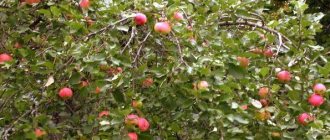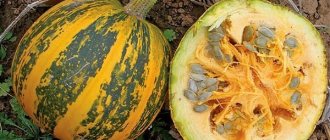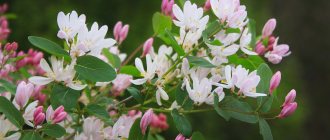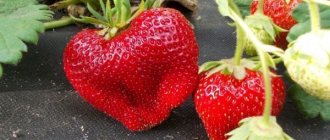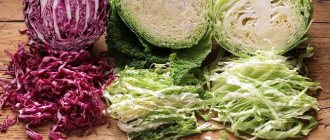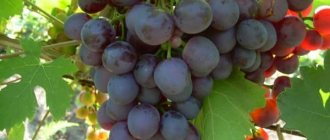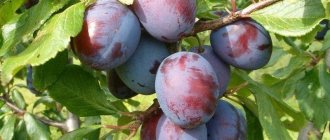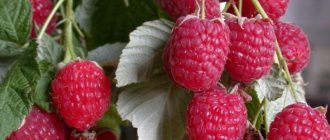Hungarian plum: variety description
Hungarian usually grows in the central regions of the Russian Federation. The variety is self-fertile. Every year the plum produces a rich harvest. The species is valued for its rich annual harvest and fruits with excellent taste. From one tree you can collect up to 30-40 kg of fruit.
Plum variety Hungarian
The trees grow up to 3 m high. The crown is wide and spherical. A lot of growth appears. The variety can withstand severe frosts. Fruiting begins from 4-5 years of cultivation.
Hungarian plums have a dark purple rind covered with a dark bluish coating. The fruits have different shapes from round to oval, weighing about 25 g. The stone is easy to separate from the pulp. The fleshy part is golden in color, dense in consistency, sweet in taste with a sour undertone. The peel is dense and bitter. The fruits ripen all at once in the last ten days of September.
Plums are well stored and transported. They can even be picked a little unripe; they ripen while lying down. So, they become less sour. They make jam, jam, and compote from Hungarian. It is dried to produce dried fruits – prunes.
Hungarian includes several types: Moscow, Wangenheim, purple, home or ordinary, Italian, winter, raisin-erik, early bull.
We recommend:
Learn about the hybrid of plum, peach and apricot - Sharafuga.
History of variety selection
The Blue Bird plum was obtained from VNIISPK, the oldest horticultural organization in Russia. The Institute is engaged in research of berry and fruit crops, as well as the development of new varieties adapted to the middle zone.
The variety was the result of cross-pollination of Kabardinskaya early and Hungarian Caucasian plums. The work was carried out at an experimental selection station in Crimea.
The authors of the variety are S. N. Zabrodina and G. V. Eremin. After variety testing in 1997, the plum was included in the state register for the North Caucasus region.
Plum variety Renclod
This is a cold-resistant variety that grows tall with a spreading and dense crown. Renklod begins to bear fruit 5-6 years after planting. Every year the yield increases. Already from a 7-8 year old plant you can harvest up to 30 kg of fruit.
White plum Renclod
It is a self-fertile species, but to increase productivity, the varieties Anna Shpet and Renklod Antanu are planted nearby.
The fruits ripen in mid-August. They have a yellow-green color, a thin skin, when they are fully ripe, they become yellow with a whitish coating. The fruits are large, spherical in shape. The contents of the fruit are yellowish in color, soft in consistency, juicy and very sweet. The pit is easy to separate.
However, this variety cannot be stored or transported, so it is grown at home. Fruits are eaten raw or processed into preserves, compotes, jams, etc.
There is another variety of Renclod plum - Altana. The fruits differ in color - greenish-golden fruits with a brown ruddy side, and have a groove. The entire peel is covered with yellow dots, it is thin but dense. The pulp is sugary, with a wine aftertaste, juicy, dense consistency. The bone is easily separated from the fleshy part.
The fruits ripen all at once in late August-early September.
Basic rules of care
Plum care consists of watering, pruning, fertilizing and loosening the soil. Proper execution of all these works will ensure a good harvest.
Trimming
Pruning helps to form the correct crown and also free the tree from diseased branches.
In the first year, pruning will only damage the young tree, which needs strength to take root well.
Plum formation begins in the second year after planting, before the buds open. If the deadlines are missed, it is better to postpone the formation until the next season. Most often, the plum crown is made leader or vase-shaped.
The leader crown consists of a conductor and 2–3 tiers of main branches. As soon as the tree reaches a height of 2–2.5 m, the conductor is cut to a side branch.
To form a crown in the form of a vase, the central conductor is cut out immediately, while laying the lower tier (3-4 branches). Since Honey White is a winter-hardy variety, its trunk height can be 40–60 cm. The branching of each branch-trunk is formed at a height of 0.5–1 m from its base, with the branches directed outward or sideways.
In the second year after planting, plum formation begins
Young trees are regularly pruned in the spring and poorly growing branches are corrected (if the branch angles are too sharp, spacers must be installed). It is necessary to remove competing shoots and thickening branches.
When the tree is fully formed, it only requires regular (every 2-3 years) thinning and sanitary pruning to remove diseased and dry branches (carried out as necessary). Old trees are rejuvenated by pruning old branches into replacement shoots.
Branches growing too close to the trunk should be corrected with spacers
A unique type of pruning is fruit thinning. It is carried out only with very abundant harvests in order to avoid shrinking of plums and reduce the load on the branches. The first thinning is done when the plums reach the size of hazelnuts, and then when they double their size.
Video: how to reduce the crown of a plum tree
Top dressing
For the first time, the tree has enough nutrients placed in the hole during planting. From the second year until fruiting begins, they limit themselves to the spring application of urea (20 g/m2) to the tree trunk.
When the tree begins to produce a harvest, it needs to be provided with additional nutrition. In the fall, each square meter of the tree trunk is fertilized with a mixture that includes:
- manure (1–1.5 buckets);
- urea (20–25 g);
- superphosphate (30–35 g);
- ash (0.2 kg).
After this, the earth is properly dug up. If the year is poor, autumn fertilization should be excluded, and the next year only summer fertilizing should be done, since excess nutrients causes the growth of branches to the detriment of crop formation. During the period of maximum fruiting, the amount of added organic matter is increased by 1.5–2 times.
One of the best natural fertilizers is compost, which can be easily prepared from any organic waste.
In summer, the plum tree needs to be fed. During the period of fruit ripening and after harvesting, add 2 tablespoons of urea and 3 tablespoons of nitrophoska to a bucket of water.
Watering and preparing for winter
It is advisable to water regularly, although Honey White tolerates drought quite satisfactorily. Usually 5–6 waterings (2–3 buckets of water per tree) per season are sufficient:
- After flowering.
- 15–20 days after the formation of ovaries.
- 30–40 days after the formation of ovaries.
- During the ripening period.
- After the harvest.
After each watering, you need to loosen the soil in the tree trunk circle to improve aeration, reduce evaporation and prevent crust formation. In the fall, deep digging is carried out: 20–25 cm between rows and 8–10 cm near the trunk. To prepare for winter, water-recharging watering is done (in October) at the rate of 5–7 buckets per tree, then the soil is mulched with humus.
In the tree trunk circle, the soil should be loose and free from weeds
On the eve of cold weather, it is advisable to whiten the trunk and wrap it and the main branches with at least a layer of paper. Although Honey White has good winter hardiness, an extra precaution won’t hurt.
Plum variety Volga beauty
These are early plums. The fruits ripen in the second ten days of August. Plums are colored reddish purple, with a waxy, bluish coating. The fruits are large, weighing up to 35 g, oval or round. The peel is of medium thickness, the contents are golden-orange. The taste is juicy, sweet without veins, with a slight sourness. The plum variety Volga Beauty is a dessert variety.
Volga beauty
After ripening, they do not fall off; they must be collected by hand. The fruits have good transportability and are stored for a long time at low temperatures and high humidity.
The Volga beauty is characterized by:
- frost resistance;
- high productivity;
- resistance to drought, even in hot and dry weather the plant feels good;
- average immunity from pests and fungal diseases;
- high self-fertility with varieties Zhiguli, Skorospelka red, Mirnoy.
The variety grows large and tall. The crown is spherical with medium density. They begin to bloom in the second half of May. Resistant to frost and drought.
Advantages
Each variety has its own pros and cons that must be taken into account when choosing a seedling.
The Mirnaya plum variety has the following positive qualities:
- high yield;
- annual fruiting;
- self-fertility, allowing you to get a harvest even without pollinating trees in the area;
- large fruit;
- dessert taste of fruits and the versatility of their use;
Gardeners prepare jam and compotes from plums, including from fallen fruits.
- good frost resistance.
and disadvantages of the variety
- Trees are not resistant to insect pests, so preventive treatment of the crown with chemicals is required.
- Dropping of fruits after ripening.
- Uneven ripening of the crop.
Plum Honey: description of the variety
Honey is also called white or yellow. The fruits grow large, yellow with a white waxy coating. Weighing up to 50 g. Their shape is regular, round. The peel is dense. The fleshy part is the same golden, juicy and sweet without streaks. Honey aroma. The stone is small and difficult to separate.
Plum Honey
This is a dessert variety; plums tolerate transportation and storage in the refrigerator well.
The fruits ripen in late July and early August. In good conditions the yield is high. During harvesting, you should not shake it off, only collect it by hand along with the stalk.
The trees grow tall up to 6 m, the crown is round with sparse branches.
Eaten fresh and used for processing.
Zarechnaya plum early
Another early ripening species. The fruits ripen evenly at the end of July. Plums have the following characteristics:
- large size, weighing up to 50-60 g, round in shape;
- shade – dark, lilac with a bluish tint;
- the peel is thick, easily removed from the fleshy part of the fruit;
- the pulp is golden-green, juicy, sugary with sourness, delicate and dense consistency without veins.
The trees grow compact and low. The crown turns out to be medium thickened, small, spherical or oval-shaped. The first harvest can be harvested after 3-4 years of growth. Productivity is high, especially if the crop grows in favorable conditions. Zarechny early is resistant to low temperatures, diseases and pests . Tolerates drought well. The fruits are evenly distributed, do not thicken it, and therefore do not become smaller over time. They keep up at the same time.
Zarechnaya early plums are of a table-technical nature. They are used to make jam, jams and compotes. They are stored for a long time and tolerate transportation well.
Aftercare for plums
A grown tree must be thinned out periodically. The Blue Egg plum has a lush crown - the branches are pruned once a year.
Trimming
Pruning is carried out in the spring, at the end of March, after frosts, before the formation of buds in the plum, using thinning and shortening methods.
Thin out a heavily overgrown crown by removing old branches and last year's shoots.
Pruning of plums is carried out with special garden tools, and the cut site is treated with garden varnish.
You can learn in detail about how to properly trim a Blue plum from this video:
Preparing for winter
When preparing young seedlings for wintering, you need to think about insulating the plum trunk. A sheet of old slate is placed in front of the tree to protect it from drafts. After a sufficient amount of snow has fallen, it is periodically thrown over an improvised fence.
If the winter turns out to be snowless, the trunk of the Blue plum is insulated with spruce branches or sawdust.
Learn more about how to prepare plums for winter in the video:
Feeding and watering
If the autumn turns out to be dry, the plum needs to be watered several times before frost sets in. Particular attention is paid to stagnation of water in the hole. The soil around the trunk should dry completely before the next watering.
Important! Do not allow water to stagnate in the hole. This can lead to rotting of the roots and bark.
Seedlings are fertilized several times a year. First time in the spring, after planting, once in the summer and again in the fall, before the weather gets colder. Fertilizing is carried out by watering with humus diluted in water or fertilizers containing potassium and magnesium. In the spring, fertilizing Egg is done with nitrogen-containing fertilizers.
Rodent protection
In autumn, in order to protect the trunk of the Egg Plum from rodents, it is wrapped with protective materials: spruce branches, raspberry and juniper branches. Such a barrier will protect not only from voles, but also from arguments during the winter thaw.
A protective layer is placed around the trunk close to the soil and tied with cloth or rope. You can wrap a layer of coniferous insulation on top with burlap or roofing felt.
Diseases and pests, methods of control and prevention
Clusterospirosis is a serious disease and the main pest of Egg plum. The disease is manifested by the appearance of red spots on the surface of the leaves. Over time, they turn into holes. The peculiarity of clusterospirosis is that it quickly spreads throughout the garden. Fungicides will help cope with it. They need to be changed periodically.
The codling moth is another pest of this variety. The caterpillars eat up the ovaries and like to feast on ripe fruits, reducing the yield. In this case, the old bark is scraped off and the trunk is treated with chemicals.
Aphids settle on young leaves in the spring. Egg plum is treated for pests 1.5 months before fruiting.
Important! You cannot treat plums with chemicals during flowering or fruit set.
Fruit rot appears on unripe fruits. It is a gray loose coating on the surface. Distributed in regions with a humid climate.
In order to prevent diseases, the affected shoots are cut off, the affected carrion is removed and burned in a timely manner. The cut areas are treated with copper sulfate. Fungal diseases are removed by spraying with a 1% solution of Bordeaux mixture.
Spraying with fungicidal preparations before flowering helps against pests.
Plum Kabardinka: photo
A variety of domestic plum, rarely grown for industrial processing. The culture grows and develops quickly; it can grow up to 6 m in height. The crown has a pyramidal shape. The branches grow thickly.
The plums are large, weighing up to 60 g. They have a deep purple hue, and the skin is covered with a waxy coating. It is thick and easily removed from the pulp. The fruit tastes juicy, sugary and sour. The fleshy part is yellow and orange, quickly becoming brownish. The bone comes off easily.
The variety has the following characteristics:
- The plant does not tolerate drought well, the fruits become smaller, and may even stop bearing fruit;
- Frost resistance is also low. The plant can withstand frosts down to -7-10 degrees. Therefore, they are grown in the southern regions. At lower temperatures it stops bearing fruit.
- Completely self-fertile species. Flowers in early April. The harvest is harvested at the end of July.
- The yield is average, about 100 kg of fruit is collected from one tree.
- The plant begins to bear fruit in the 5th year.
- High immunity to gray rot, red spot and other fungal diseases.
- Rarely affected by pests, resistant to codling moth.
- Fruits are stored for a long time and can withstand transportation.
They are eaten fresh and used for processing into jam, compote, and juices. They can also be dried and frozen.
Plum Blue Gift: description of the variety
For the most part, the variety grows in the southern regions, but is beginning to become popular in the central regions. This crop can even grow and bear fruit in Siberian conditions. It reaches a height of no more than 3 m, the crown is compact, oval and elongated, the branches do not thicken. Therefore, there is no need for regular pruning.
The plums are small, weighing 15 g. They are easily separated from the stalk. The peel is a dark purple color with a dark coating. The pulp is sweet, juicy, dense. Lots of fibre. The fruits are aromatic with a slight sourness.
Important characteristics:
- Does well on loose soils with neutral acidity;
- Suitable for growing for industrial processing: preserves, marmalade, compotes and juices;
- The plant loves moisture, but it is not worth overwatering;
- Self-pollinating, blooms at the end of May;
- Fruiting begins at 3 years of age;
- Up to 40 kg of crop is harvested from one tree;
- Withstands low temperatures well, suitable for growing in the middle zone;
- It is required to regularly treat against fungal diseases and pests.
Landing
For planting, 1 or 2 year old seedlings with a well-developed root system are selected. Due to its winter hardiness, the seedling can be transplanted into the ground in the fall, however, the optimal time for planting is spring. The work is carried out even before the buds open.
For planting, you must choose a well-lit place where water does not stagnate, and groundwater is located at a depth of at least 1.5 m. The plant prefers well-drained soils with a low acidity level. The seedling will feel best on loam treated with lime or dolomite flour.
The preparation of a “permanent place of residence” for plums begins in the fall. The soil on the site is dug up with lime and they begin to dig a planting hole using the following algorithm:
- Dig a hole to a depth of 60 cm and a diameter of 70 cm. Fertile soil (top layer about 20 cm) is set aside separately to prepare the soil. The rest is scattered evenly along the garden paths.
- A thick support stick is placed at the bottom and about 500 g of wood ash is poured.
- Soil is poured on top, which is prepared in the following proportions: 1 bucket of humus or compost per 2 buckets of fertile soil + 400 g of superphosphate (based on the entire pit).
- The hole is covered with waterproof material and left to “rest” until spring.
- Before planting, the roots of the seedling are dipped into a clay and manure mash. This way he will settle in well.
During planting, growth stimulants can be used.
- In the spring, the hole is dug out about halfway. A small mound is formed at the bottom on which the seedling is placed.
- The roots are straightened in different directions and carefully buried. It is necessary to ensure that the root collar is located above ground level.
- The seedling is tied to a support (not too tightly, but not loosely either).
- Form a circle near the trunk and water the tree with 2 buckets of water.
- The earth is mulched with humus or peat.
Plum – variety Morning
Early ripening plums that ripen in the first ten days of August. Ripe fruits are green-yellow in color, so they are difficult to distinguish from unripe ones.
The trees grow low with a spherical crown. The branches thicken at an average speed, so annual pruning may not be necessary.
The fruits are quite large. Average weight - 30-40 g. There may be blush on one side. The peel is smooth with a waxy coating. The stone separates from the pulp easily. The inside of the fruit is golden. The consistency is delicate, dense, sugary with sourness. The aroma is rich and bright.
The variety has the following characteristics:
- Good transportability;
- Suitable for fresh and processed consumption;
- Self-fertile and self-pollinating species;
- Low frost resistance; at very low temperatures, branches and flowers freeze, but quickly recover;
- A fast-growing variety, it begins to bear fruit at 3-4 years of age.
Columnar plum variety Imperial
The columnar plum variety Imperial grows small, no higher than 2 m. The shape is elongated, pyramidal. The density of branches is average. Basically only the skeletal main ones, new ones grow every year for fruiting.
Fruits grow evenly throughout the crown. Color – pink with a purple tint. Sometimes they are brownish in color. The plums are large, weighing up to 50-60 g. The pulp is golden, sweet with sourness, juicy and tender. The honey taste remains.
The species is characterized by:
- Frost-resistant, young seedlings do not tolerate low temperatures;
- Does not tolerate drought well. The root system is located close to the surface, so the plant cannot obtain water itself. In hot, dry summers, additional watering is required.
- Self-fertile species, but requires pollinators: Renclaude, Stanley.
- It begins to bear fruit at the age of two.
- The Imperial plum ripens in mid-August. Ripe fruits do not fall off and must be picked by hand;
- Fresh ones can be stored for no more than two weeks; they do not tolerate long transportation.


